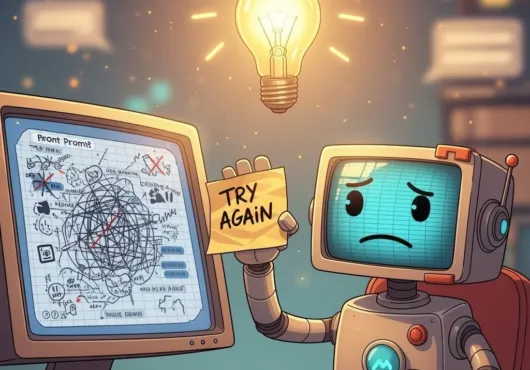Prompt debt compounds the moment you hit ‘Run again.’
VibeAxis
AI feels fast. You throw a messy idea at a model, it throws back something “good enough,” and everyone moves on. That speed is intoxicating—and it’s how teams quietly rack up prompt debt. You save five minutes per task while creating a thousand tiny inconsistencies you’ll pay for later in edits, support tickets, and “why did we ship that” meetings.
Prompt debt is like credit card interest: the balance isn’t scary on day one. Three months in, you’re wondering why everything smells like smoke.
Every “quick prompt” you duct-tape into your process creates prompt debt.
Hidden rework, weird edge cases, and institutional amnesia that compounds over time.
You don’t need more prompts; you need a protocol.
What prompt debt looks like in the wild
Content teams ship posts generated with five different tones because each writer keeps a private prompt note. The brand voice drifts. Your site reads like a group chat.
Support uses “fast” macros the model happily hallucinates around. Now you’ve got contradictory answers in zendesk threads and a churn graph shaped like a ski slope.
Ops automate little tasks—renaming files, summarizing calls—without versioning the prompts. Someone tweaks one line and your filenames turn into lorem ipsum for a week.
None of this is dramatic enough to trigger a postmortem. It just makes everything… worse.
The physics of the problem (and why more tokens won’t save you)
Models don’t remember your system—you do. A prompt is not a spec; it’s a suggestion. If your instruction relies on “the vibe,” the output depends on whoever wrote it, whatever changed since last week, and which model feels sassy today. That’s not a workflow. That’s gambling with better fonts.
The protocol (how to cut the interest rate)
Keep a little bold, keep it tight:
1) Standardize the promise, not the prose.
What does this prompt guarantee? Outcome, format, boundaries. If you can’t state the promise in one sentence, you’re writing fiction.
2) Version everything that touches money or reputation.
Name it like code: title-gen_v3_2025-08-09.md. Log the change and why you made it. No mystery meat prompts.
3) Separate “what” from “style.”
The what is the task and fields; the style is brand voice. Keep voice in a reusable block you can update once, not fifty times.
4) Force inputs through a form.
Humans should fill fields, not vibes. “Product name / audience / claim / source URLs.” Garbage in, garbage scaled.
5) Add a stop condition.
Define failure: “If no credible source is provided, return ‘NEEDS SOURCE’ instead of guessing.” Your future self will send flowers.
6) Make review a role, not a favor.
One person owns acceptance criteria. Their job is to say “nope” quickly, not massage trash into passable content.
A tiny example (that saves hours)
Bad prompt:
“Write a product blurb about our new AI note-taker.”
Clean prompt (promise stated):
“Return a 120–150 word product blurb for a landing page. Must include: audience, one problem, one outcome, one proof point (from provided sources). Tone: confident, irreverent, no jargon. If no valid proof link is provided, output ‘NEEDS SOURCE.’
Fields:
Product:
Audience:
Problem:
Outcome:
Proof URL:”
Now it’s legible to humans, enforceable by reviewers, and reusable across models. That is interest you’re not paying.
How you know you already owe the bank
You keep “fixing it in post.”
Two people can’t get the same result from “the same” prompt.
Brand voice drifts week to week.
Nobody can find the latest version.
You’re scared to switch models because your prompts are duct-taped to one of them.
If that stung, the balance is due.
Migration without the migraine
Pick one workflow this week—the one that generates the most junk or touches customers. Write the one-sentence promise. Split what vs. style. Force inputs through a tiny form (even a Google Form). Version the prompt. Appoint a reviewer with veto power. Run it for seven days. Then measure: fewer edits? Faster approvals? Fewer “what is this” Slacks? If yes, clone the pattern. If no, the promise is wrong—rewrite that, not the adjectives.
The part nobody wants to hear
Prompt engineering is not a party trick; it’s editorial ops with guardrails. You don’t solve prompt debt by hiring “a prompt person.” You solve it by acting like your prompts are product.
The payoff
Less rework. Cleaner handoffs. Outputs you can trust at 2 a.m. And when you swap models next quarter (because you will), your system survives because it isn’t married to one model’s quirks.
You can keep speed and stop setting fires. That’s the value. That’s the brand.



